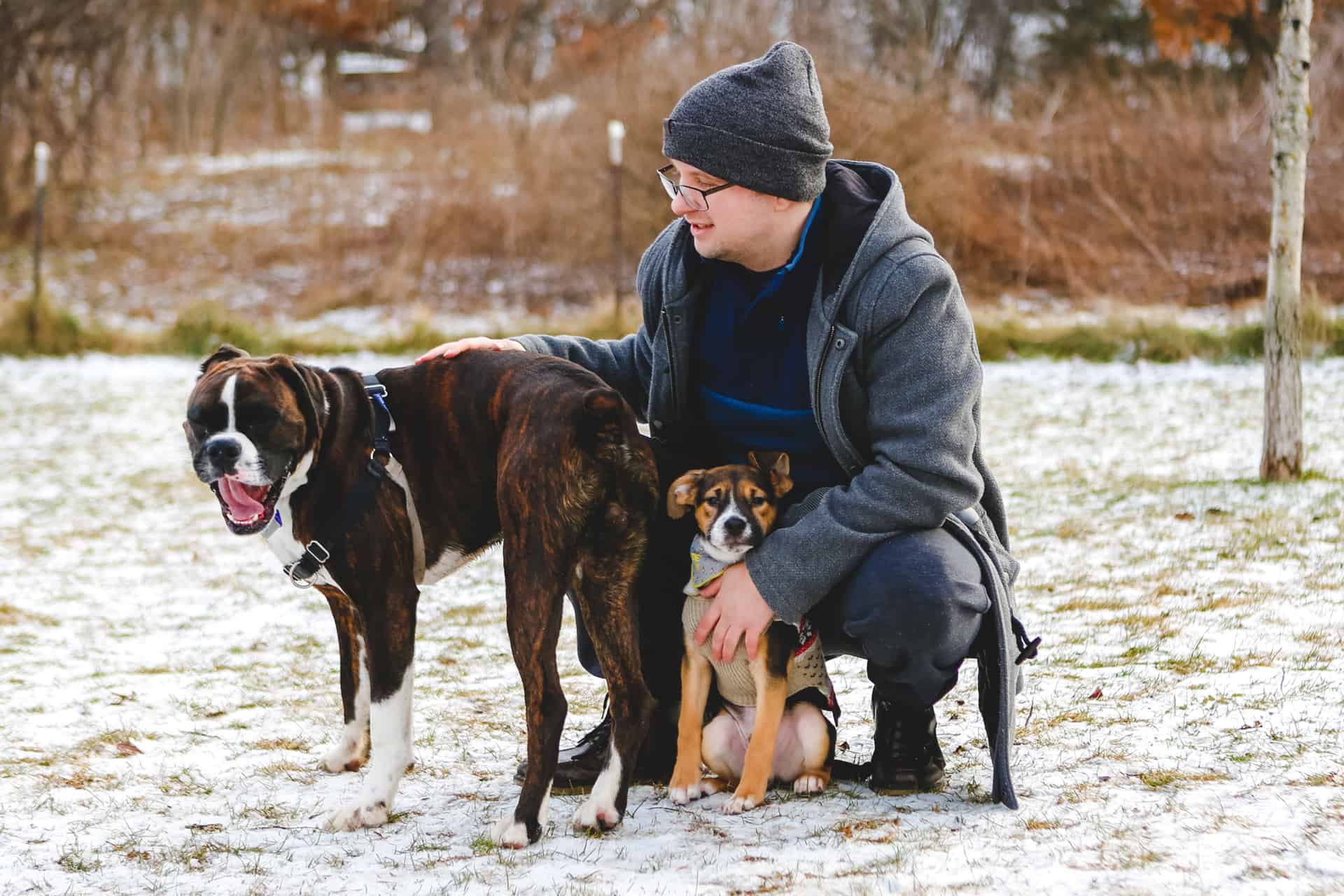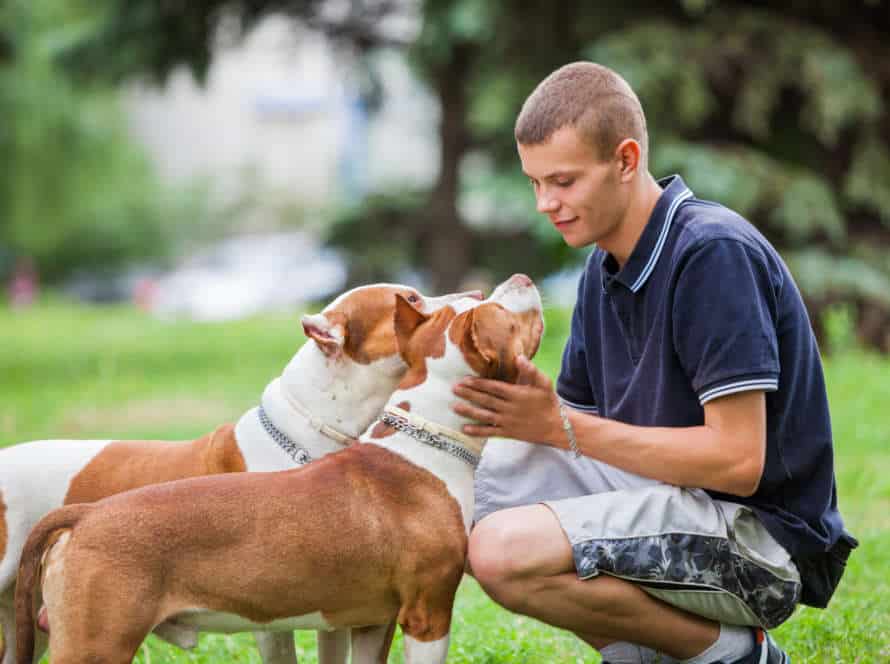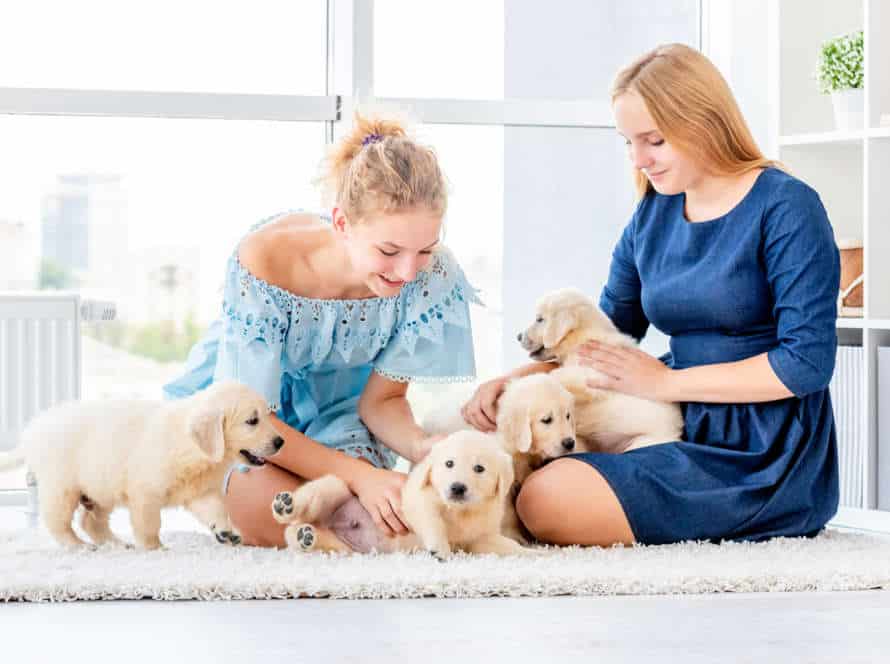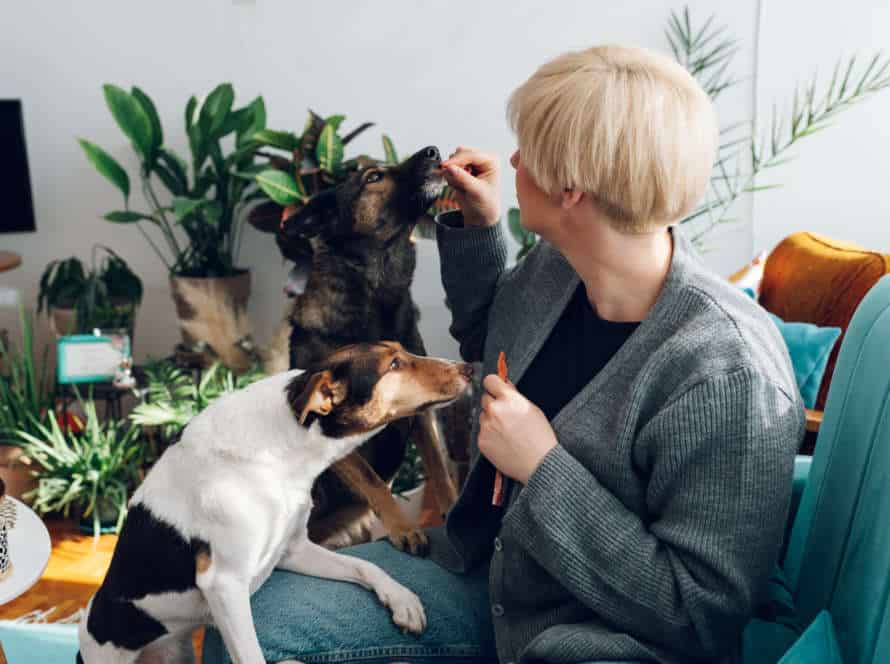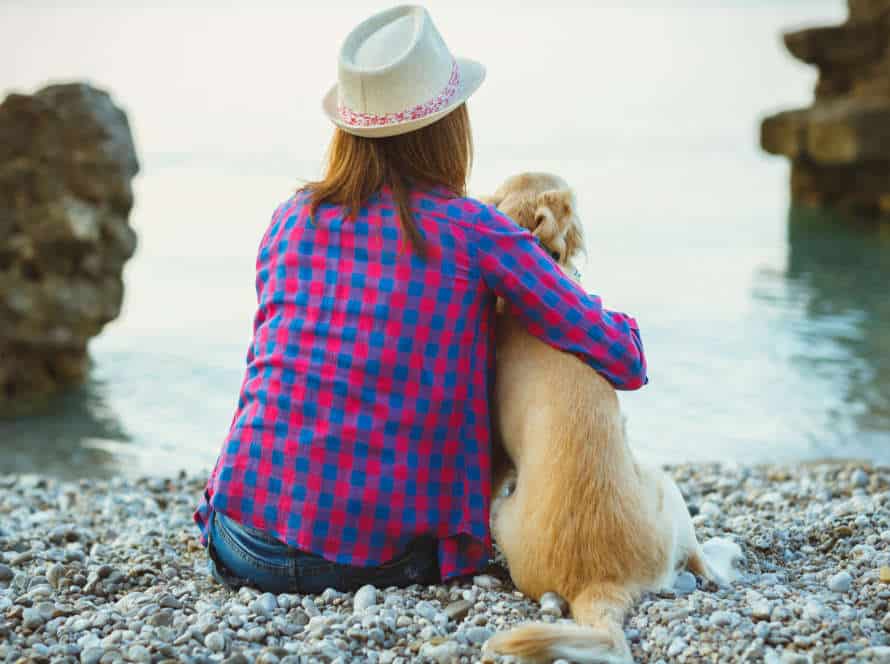Building Trust: Reducing Resource Guarding Through Positive Reinforcement
Resource guarding in dogs is a common behavior that can lead to aggression. Positive reinforcement and building trust can help reduce this. Here are tips to reduce resource guarding:
- Offer high-value treats to your dog near his food bowl or toy, but don’t take it away.
- Increase your proximity gradually with treats. If your dog becomes aggressive, stop and try again later.
- Practice taking and returning the object with a treat. Increase the duration of the removal each time.
- Positive reinforcement will teach your dog that humans coming near his resources is a good thing.
- Be patient and never punish or use force.
Understanding Resource Guarding
Resource guarding is an issue pet owners can experience. It happens when pets act possessive or protective of food, toys, people, and other resources. It can become serious if not taken care of. It is usually managed using positive reinforcement training.
What is resource guarding?
Resource guarding is when pets exhibit possessive or protective behavior towards their resources, such as food, toys, or people. This behavior can manifest as growling, snapping, or even biting.
How can it be lowered?
Resource guarding can be lowered through positive reinforcement training. This involves rewarding the pet for displaying non-aggressive behavior around their resources. It is important to approach resource guarding with caution and seek the help of a professional if needed.
Remember, early intervention and positive training can help manage resource guarding and create a safe and happy environment for both pets and their owners.
What is Resource Guarding?
Resource guarding is when a dog protects its stuff. This includes food, toys, beds, and even its owner. If not dealt with, it can lead to aggression.
Here’s how to reduce it using positive reinforcement:
- Build trust with your pet by petting them and rewarding them when they do something good.
- Positively reinforce good behavior around resources by giving treats, toys, or praise.
- Counter-conditioning can also help. Gradually introduce your pet to new places and activities to build their confidence and reduce anxiety that could cause resource guarding.
- If you’re having trouble, seek professional help. A vet or dog trainer can help you. Patience, consistency, and positive reinforcement are key.
Why do dogs guard resources?
Resource guarding is a typical doggy action. They guard their possessions, such as food, toys and even their owners. In the wild, it is a natural reaction to make sure they can survive when things are limited. Here are a few reasons why they may guard resources:
- Fear: If a pup was deprived of things before, they may be scared that they will lose them again.
- Dominance: Some dogs may guard resources to show they are in charge.
- Past Experiences: If a pup had a bad experience with losing something, they may guard resources aggressively.
To reduce resource guarding behavior in pups, positive reinforcement training is key. Building trust with the dog, giving them enough resources and rewarding them for good behavior, can help them feel more secure and less likely to guard things.
How can resource guarding lead to aggression?
Resource guarding is a behavior that can lead to aggression in dogs. It’s when they show protectiveness or aggressiveness over an item, like food, toys, or even people. Signs of this include stiffness or growling when approached, as well as snarling, snapping, or biting.
Here are some reasons why resource guarding can cause aggression:
- The dog feels scared it’ll lose what it has, leading to insecurity and anxiety.
- The innocent being can be seen as a threat to the dog’s resources, so it gets defensive or even offensive.
- If the dog has been trained harshly before, resource guarding can easily escalate to aggression.
- Using Positive Reinforcement can help build trust between the dog and its owner. This will make the dog associate humans, activities, and objects positively, reducing resource guarding and eventually aggression.
Positive Reinforcement for Resource Guarding
Resource guarding? It’s a common issue in dogs. But, don’t worry! Positive reinforcement is here to help. It builds trust between you and your pup while reducing resource guarding behavior.
Let’s explore the techniques of positive reinforcement that can help with this.
What is positive reinforcement?
Positive reinforcement is a way to train behavior. It rewards a behavior to increase the chance of it happening again in the future. For resource guarding in pets, positive reinforcement is very useful. It builds trust and stops aggressive behavior.
Here are 3 ways to reduce resource guarding with positive reinforcement:
- Give treats or praise when they let you take their prized possessions without being angry or biting.
- Reward them with attention, playtime, or treats when they obey commands like “leave it” or “drop it.”
- Slowly up the value of the reward for good behavior. Offer better treats or longer playtime.
Using positive reinforcement will create a stronger bond with your pet and lower their need to guard resources.
How does positive reinforcement work in regards to resource guarding?
Positive reinforcement is a training tech that works by rewarding behaviors which should be repeated. It works to reduce resource guarding in dogs. Here’s how it works:
- Offer your dog a treat or toy they value.
- When they take it, use a soothing voice to praise and give more goodies.
- Do this over time till they link your approach with rewards.
- Increase the interactions with you while you handle their resources.
- Reward each positive interaction.
This way, they’ll learn to trust you and have positive experiences when you’re around their resources. This will reduce resource guarding in the long run.
Benefits of positive reinforcement vs punishment
Positive reinforcement and punishment are two popular training methods. However, positive reinforcement is a much more effective and humane way of teaching your pooch not to protect their belongings. Let’s look at the benefits of positive reinforcement over punishment:
- Establishes trust: Positive reinforcement involves rewarding good behavior, helping your dog form trust and a strong bond with you.
- Forms a safe environment: With positive reinforcement, your pup feels secure and trusts you, lessening the need to guard their resources.
- Improves behavior: Positive reinforcement reinforces desirable behavior, teaching your pup to repeat the action to get a reward.
- Reduces anxiety: Punishing your pup can make them anxious and may even lead to more guarding of their possessions. Opting for positive reinforcement can reduce your pup’s anxiety and strengthen your bond.
Identifying Triggers and Signs
Resource guarding – being overly protective of a resource, like food, toys, or attention – is a problem many pet owners experience. To reduce it, we must identify triggers and signs of the behavior. Let’s take a closer look! We’ll then discuss the best strategies to reduce resource guarding through positive reinforcement.
How to identify triggers that lead to resource guarding
Resource guarding is a habit seen in dogs, which can become aggressive if not taken care of. Recognizing what causes your dog to guard resources is important for having a peaceful relationship with them. Here’s how to spot the triggers of resource guarding:
- Watch your four-legged friend’s body language and behavior when they have something special like food, toys, or treats.
- Look out for signs like growling, snapping or showing their teeth.
- Find out what makes your pup feel threatened or anxious, like another pet, a person, or a loud noise.
- Once you know what the triggers are, use positive reinforcement and behavior modification methods to desensitize your dog. This will decrease their anxiety and build trust, which should lessen their resource guarding behavior.
Pro tip: If you’re unsure how to modify your pup’s behavior, talk to an expert dog trainer or animal behaviorist.
What are the signs of resource guarding?
Resource guarding is a common behavior in dogs. You can spot it by watching for certain signs:
- Growling or snarling when they’re playing, eating, or holding something.
- Stiff body, eye contact, and showing teeth when approached.
- Eating rapidly, hiding or burying items, or trying to move stuff away.
- Not dropping or releasing the item when asked.
If you see any of these signs, get help from a professional. Positive reinforcement and trust-building can reduce resource guarding.
Importance of recognizing triggers and signs
Recognizing triggers and signs of resource guarding is key for creating trust with your pet.
Triggers like getting close when they’re eating, or taking away a valuable item, can lead to negative behavior. Snarling, growling, and biting are all signs to look out for.
To avoid these reactions, use positive reinforcement. Offer treats, play games, and reward good behaviour. This builds a positive association with training and reinforces good habits.
With patience and determination, you can help your pet learn to let go of resource guarding and build a stronger bond of trust and respect.
Implementing Positive Reinforcement Techniques
Positive reinforcement is a wonderful way to reduce resource guarding in dogs. Reward or positively reinforce the desired behaviour, and gradually decrease the intensity. Implementing these techniques builds trust and confidence with your dog, creating a calmer environment. Here’s how to do it:
Desensitization and counter-conditioning
Desensitization and counter-conditioning are two powerful positive reinforcement techniques. They can reduce resource guarding behavior in dogs. This is done by building trust and creating positive associations.
Desensitization involves introducing the dog to the trigger item gradually in a controlled environment. Counter-conditioning pairs the trigger item with positive reinforcement, such as treats, toys, or praise. This creates a positive association in the dog’s mind. Combining these two techniques builds a stronger bond based on trust and positive reinforcement.
Note: Always consult a professional dog trainer or behaviorist before attempting any behavior modification techniques.
Teaching the “give” command
Teach your pup the “give” command. This builds trust and encourages positive reinforcement to reduce resource guarding.
How? Start with a low-value treat your dog likes, but isn’t too attached to.
- Hold the treat in a closed hand and offer it to your pup.
- When your pup sniffs, licks, or paws at your hand, say “give” or “drop”.
- Then, offer a different treat from your other hand.
- Repeat several times until your pup understands that dropping the first treat means a more desirable reward.
- Gradually increase the value of the treat, and practice in different environments. This reinforces your pup’s understanding of the command.
With patience and consistency, your pup will learn to trust you and drop items when asked. Resource guarding is thus reduced.
Building trust through positive interactions
Positive reinforcement can help reduce resource guarding in pets. Resource guarding can make pets, especially dogs, aggressive or possessive. To retrain a pet’s behavior, use positive reinforcement.
- Reward good behavior with treats, cuddles, or playtime.
- Avoid physical punishment.
- Reduce exposure to triggers.
Positive reinforcement requires time & patience. It can reduce resource guarding & build the human-animal bond.
Pro tip: Consult a professional if resource guarding persists or escalates.
Conclusion
Resource guarding in dogs can be reduced through positive reinforcement. Be consistent in rewarding desired behavior. Give a distraction or redirection if guarding appears. Provide plenty of resources. These techniques give dogs the security to reduce guarding and build trust with their owners.
Benefits of positive reinforcement for resource guarding
Positive reinforcement is a powerful tool for reducing resource guarding in pets and creating trust between them and their owners. Reward good behavior, like sharing, and resist the urge to punish. Through this, pets will associate sharing with positive experiences.
Benefits of positive reinforcement for resource guarding:
- Builds trust – pets learn that sharing = pleasant experiences
- Reduces aggression – they’re more likely to share when rewarded than punished
- Increases obedience – easier to respond to commands, like “leave it” or “drop it”
Positive reinforcement can help pets overcome resource guarding and build strong bonds with their owners.
Importance of seeking professional help if necessary
Reducing resource guarding with positive reinforcement is important. Seek help if needed. Growling, lunging and biting need professional treatment.
Seeking a dog trainer or veterinarian ensures safety for both you and your dog. It also prevents the issue from getting worse. Professional help finds the root cause of the guarding and creates a customized plan.
Also, it can build trust between you and your dog, making them feel safe and loved. Avoiding help can make the issue worse and have long-term negative impacts on their health.
Frequently Asked Questions
1. What is resource guarding?
Resource guarding is a natural behavior in which dogs protect their food, toys, or other possessions from perceived threats. This behavior can vary in intensity from mild growling to aggressive attacks.
2. How can positive reinforcement help reduce resource guarding?
Positive reinforcement involves rewarding desired behaviors, such as dropping or sharing a toy, rather than punishing unwanted behaviors like growling or biting. This approach creates a more trusting relationship between you and your dog, reducing the need for them to guard resources.
3. What are some examples of positive reinforcement for reducing resource guarding?
Some examples include giving your dog treats for allowing you to take their toy or food bowl away, playing games that encourage sharing, and providing a variety of toys and chews for your dog to enjoy.
4. What are some signs that my dog may be resource guarding?
Signs of resource guarding can include growling, snapping, stiffening or freezing when approached near items they value, or refusing to give up an item without a fight. It is important to seek professional help if you notice any of these behaviors in your dog.
5. Can resource guarding be completely eliminated?
While some dogs may always have a tendency to resource guard, positive reinforcement can significantly reduce the intensity and frequency of this behavior.
6. What should I do if my dog displays aggressive resource guarding behavior?
If your dog displays aggressive resource guarding behavior, it is important to seek professional help from a certified dog trainer or veterinary behaviorist. They can work with you and your dog to develop a customized training plan that addresses your specific situation.

